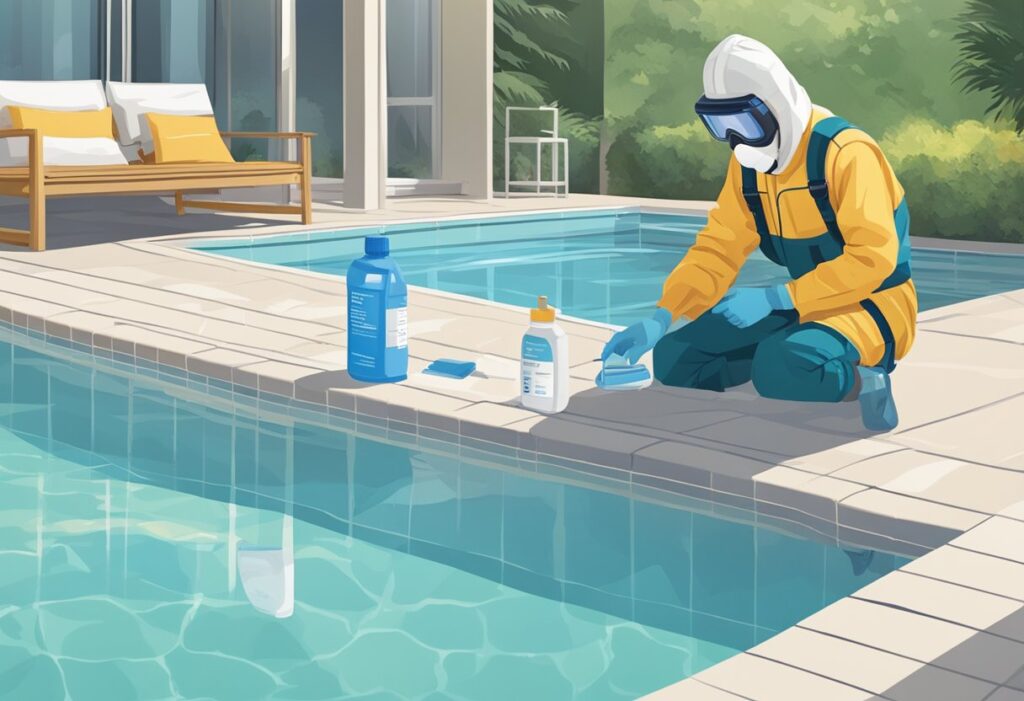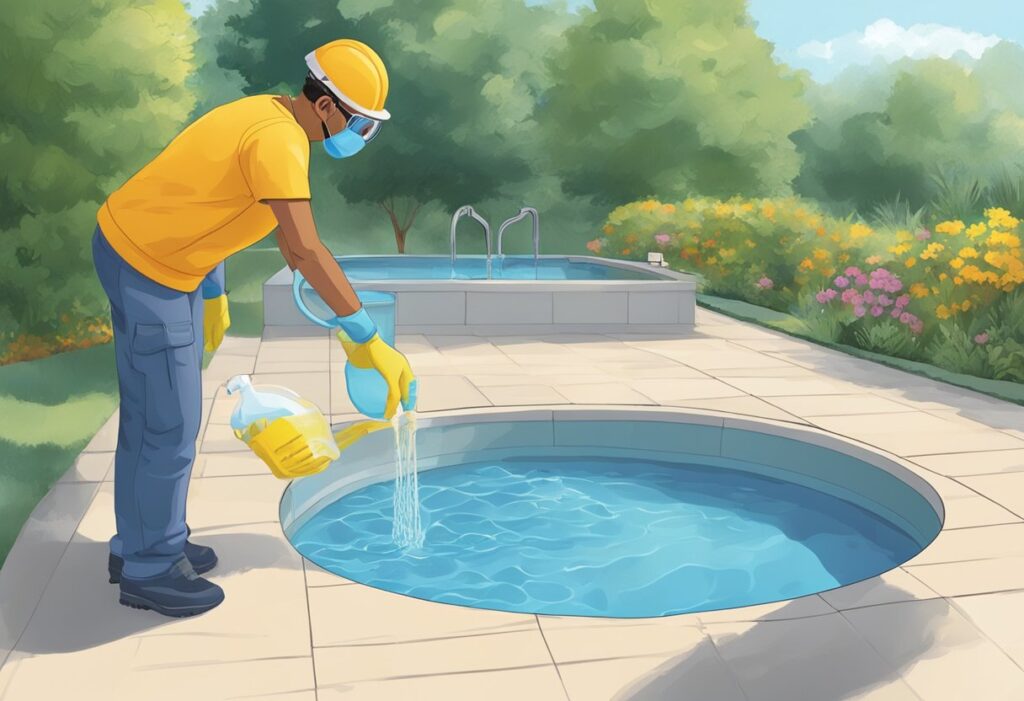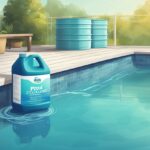Maintaining the chemical balance in your pool is crucial for ensuring a safe and enjoyable swimming experience. High alkalinity is a common issue that can affect both the comfort of swimmers and the condition of your pool. When the total alkalinity of your pool water exceeds the recommended levels of 80 to 120 parts per million (ppm), it can lead to cloudy water, scaling, and an imbalanced pH that’s difficult to adjust.

Lowering the alkalinity of your pool is a relatively straightforward process that requires the use of chemicals like muriatic acid or sodium bisulphate. These chemicals can effectively decrease high alkalinity levels, but it’s important to handle them with care. Muriatic acid, while more powerful, is a corrosive substance and can be hazardous to both you and your pool surfaces if not used correctly. On the other hand, sodium bisulphate is a granular acid and offers a safer alternative with less risk of damage or toxicity.
In correcting high alkalinity, it’s vital to follow the manufacturer’s guidelines and take the necessary safety precautions. Accurate measurements and careful application are key to successfully reducing alkalinity without upsetting the overall water chemistry. Regular testing of your pool’s alkalinity ensures that you maintain the right balance for a clean, clear, and comfortable swimming environment.
Understanding the Basics of Pool Chemistry
Managing your pool water chemistry is critical for ensuring a safe and pleasant swimming experience. By understanding a few key concepts, you can maintain a balanced and comfortable environment for all swimmers.
pH Level: This indicates how acidic or basic your pool water is. A pH scale ranges from 0 to 14, with 7 being neutral. Ideally, you aim for a pH level between 7.4 to 7.6, similar to the pH of the human eye, to prevent irritation.
Total Alkalinity: This refers to the water’s ability to neutralise acidity, serving as a buffer for the pH level. Maintaining proper total alkalinity levels, typically between 100 to 150 parts per million (ppm), helps stabilise the pH and enhances chlorine effectiveness.
To prevent high alkalinity, avoid overuse of alkaline substances like sodium bicarbonate. If your pool’s total alkalinity levels are too high, you’ll need to lower alkalinity to prevent problems that can impair water quality and damage pool surfaces.
Pool Chemicals: A balanced water chemistry requires various pool chemicals. You’ll need to know how these chemicals interact with each other and the water:
-
Chlorine: Keeps the water sanitary by eliminating harmful bacteria and controlling algae growth.
-
Sodium Bicarbonate: Used to increase alkalinity if levels are low.
-
Acids: Such as muriatic acid or sodium bisulphate, are used to lower both pH and alkalinity when levels are too high.
Remember, adding chemicals to your pool should be done carefully and according to guidelines, as incorrect amounts can negatively impact water chemistry and swimmer comfort.
Testing and Adjusting Alkalinity Levels
Maintaining proper alkalinity levels in your pool is crucial to ensure water quality and prolong the life of pool equipment. This section will guide you through the materials you’ll need, how to accurately conduct a total alkalinity test, and how to interpret the results to keep your pool within the ideal alkalinity range.
Gathering Required Materials
Before you begin testing the alkalinity of your pool water, it’s essential to have the right materials on hand:
- Total Alkalinity Test Kit: This can be a liquid reagent kit or test strips specifically designed to measure the total alkalinity.
- Clean, Plastic Water Collector: To obtain a water sample without contamination.
- Gloves and Safety Goggles: For protection when handling pool chemicals.
Performing the Test
To accurately measure the total alkalinity, follow these steps:
- Collect a Water Sample: Using the water collector, gather water from 30-45 cm deep.
- Apply Test Reagents: (If using a liquid test kit) Add the specified amount of reagent to the water sample, following the test kit’s instructions.
- Use Test Strips: (If using test strips) Dip the strip into the water sample and hold it there for the time specified by the manufacturer.
- Wait for the Reaction: Allow the reagents or strips to react with the sample for the recommended amount of time.
Interpreting Test Results
The test results will indicate the total alkalinity of your pool water, measured in parts per million (ppm):
- A Healthy Range: Ideal total alkalinity levels for pool water typically range from 80-120 ppm.
- Reading the Results: For liquid tests, compare the colour change to the provided chart. For test strips, match the strip’s colour to the chart on the test kit.
- Taking Action: If the total alkalinity is above 120 ppm, you’ll need to take steps to lower it, and if it’s below 80 ppm, you will need to raise it.
By closely monitoring and adjusting your pool’s alkalinity levels to stay within the ideal range, you can avoid fluctuations in pH levels and ensure a safe, comfortable swimming environment.
Methods for Lowering Alkalinity
To maintain a balanced pool, you need to effectively lower the high alkalinity level. Several methods are at your disposal, but it’s essential to approach this process with accuracy, especially when dealing with chemicals.
Using Muriatic Acid
To safely use muriatic acid:
- Turn off the pool pump and ensure the water is still.
- Calculate the required dosage of muriatic acid. For example, approximately 760 ml of full-strength muriatic acid will lower the alkalinity by 10 parts per million (ppm) in a 38,000-litre pool.
- Dilute the acid if recommended, by adding it to water in a large bucket.
- Pour the acid into the deepest part of the pool, distributing it evenly.
Applying Sodium Bisulfate
Alternatively, you can use sodium bisulfate, commonly known as dry acid:
- Measure the correct amount of sodium bisulfate, typically stated on the product packaging based on your pool’s volume.
- Sprinkle the granules across the pool surface evenly.
Using dry acid is considered safer compared to liquid muriatic acid and is just as effective in reducing both pH and total alkalinity.
Alternative Methods
While chemicals are commonly used, consider these other methods:
- Baking soda (sodium bicarbonate) can raise total alkalinity without significantly influencing pH levels.
- Aeration can expedite the process of increasing pH after total alkalinity has been adjusted. The use of an air compressor or by causing water agitation can help in aeration.
By following these guidelines, you can lower the alkalinity in your pool with precision and safety. Remember, always add acid to water (if dilution is necessary), and not the other way around, to prevent a potentially dangerous reaction.
Safety and Maintenance Considerations

When lowering the alkalinity of your pool, it’s essential to handle chemicals with care and establish a routine for regular maintenance to ensure the safety and clarity of your pool water.
Handling Chemicals
It is vital to wear safety gear, such as goggles and protective gloves, when managing pool chemicals, especially when using full-strength muriatic acid, which is highly corrosive. Always introduce chemicals to water rather than the reverse to prevent dangerous reactions. Use a clean plastic bucket, if recommended, for diluting chemicals before application.
- Muriatic Acid Safety: Exposure to muriatic acid can lead to serious injuries.
- Wear rubber gloves and goggles
- Work in ventilated areas to avoid inhaling fumes
- Carefully follow the manufacturer’s instructions
- Dilute acid if instructed before adding it to the pool
- Pour acid into the pool water near the return line for better distribution
Regular Maintenance Routines
A strict maintenance schedule will help in balancing not just alkalinity but also the overall chemical composition of your swimming pool. Regularly check and adjust chlorine levels to ensure free chlorine remains effective. Keeping the pool pump and filter system in check will prevent cloudy pool water.
- Weekly checks should include:
- Testing and adjusting chemical levels
- Shock treatment if needed
- Inspection and cleaning of filters
- Confirming pump operation for appropriate water circulation
By maintaining a strict schedule and properly handling chemicals, you reinforce the safety of your pool for all swimmers and the longevity of your pool’s equipment. Regular attention to these elements will mitigate problems such as cloudy water or damage from corrosive substances.











